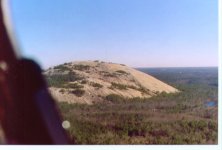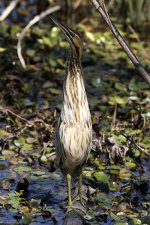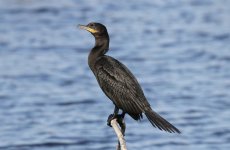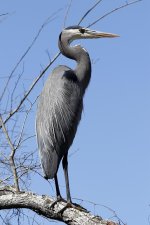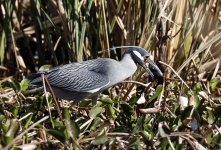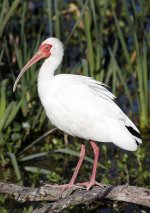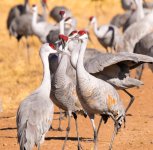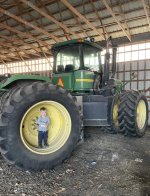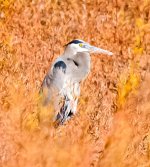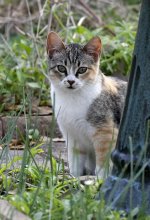You are using an out of date browser. It may not display this or other websites correctly.
You should upgrade or use an alternative browser.
You should upgrade or use an alternative browser.
Random Object Photographs
- Thread starter opaul
- Start date
Took a drive out to Brazos Bend State Park this morning and spent 3.5 hours hiking around and taking pictures. Best find of the day was the hearing aid that a older lady lost on the trail. I heard some of the people who were helping her look talking about it and when I looked ahead of me, there it was. Glad I came out today. Here are some of the better pics I ended up with. American bittern, neotropic cormorant, great blue heron, yellow-crowned night heron with crayfish, and a white ibis.
Attachments
Is that a Glad container with some kind of dessert in it? I have some of those with desserts in them as well.
Stone Mountain, GA. from a Sikorsky S-76B.
Was just there last May. Beautiful place, and I hiked up and down the rock. Later that evening had a great catfish dinner in Atlanta, then shot a round of sporting clays at Cherokee Rose the following day.
I like Georgia, nice people and lots to see and do.
Last edited:
I just dipped my toes into the deep and expensive waters of the astrophotography hobby. I bought a Star Adventurer GTi equatorial mount, ZWO ASIAIR Plus, and ZWO guide scope with ASI120mm mini camera to use with my DSLR camera. The ASIAIR Plus along with the guide scope automates the finding and tracking of celestial objects and controls all the functions of the DSLR camera along with guiding the GTi mount. You set up and monitor everything through the ASIAIR from the app on your phone or tablet.
The stars were imaged using a Nikon D7200 camera with a Sigma 150-500mm zoom lens. All the processing of the photos was done with free software Deep Sky Stacker, GraXpert, Siril, and GIMP.
These are the first 5 results of four different nights with temperatures varying from -3F on the first night to a more reasonable 30F during a couple of the the other sessions.
This is a section of the sky in the constellation Ursa Major. On the left is M 82 the Cigar Galaxy. Center is M 81 Bode's Galaxy. The fuzzy spot at the bottom center is NGC 3077 the Garland Galaxy. Upper right is NGC 2976 a dwarf galaxy.
Lens at 500mm, ISO 1000, 17 300-second exposures.

M 33 Triangulum Galaxy
500mm + 1.4x teleconverter, ISO 1600, 30 180-second exposures.

M 45 Pleiades
500mm + 1.4x teleconverter, ISO 1600, 20 60-second exposures.

M 42 Orion Nebula
400mm, ISO 1600, the best 78 out of 94 30-second exposures.

NGC 2246 Rosette Nebula
500mm, ISO 1600, the best 80 of 100 60-second exposures.

Costs are already starting to spiral up. I picked up a used 73mm 430mm focal length refractor telescope this past weekend and ordered a dedicated astrophotography camera.
 I might have to start finding things to post in the classifieds section from my other expensive hobby to fund this expensive hobby.
I might have to start finding things to post in the classifieds section from my other expensive hobby to fund this expensive hobby.
KO
The stars were imaged using a Nikon D7200 camera with a Sigma 150-500mm zoom lens. All the processing of the photos was done with free software Deep Sky Stacker, GraXpert, Siril, and GIMP.
These are the first 5 results of four different nights with temperatures varying from -3F on the first night to a more reasonable 30F during a couple of the the other sessions.
This is a section of the sky in the constellation Ursa Major. On the left is M 82 the Cigar Galaxy. Center is M 81 Bode's Galaxy. The fuzzy spot at the bottom center is NGC 3077 the Garland Galaxy. Upper right is NGC 2976 a dwarf galaxy.
Lens at 500mm, ISO 1000, 17 300-second exposures.

M 33 Triangulum Galaxy
500mm + 1.4x teleconverter, ISO 1600, 30 180-second exposures.

M 45 Pleiades
500mm + 1.4x teleconverter, ISO 1600, 20 60-second exposures.

M 42 Orion Nebula
400mm, ISO 1600, the best 78 out of 94 30-second exposures.

NGC 2246 Rosette Nebula
500mm, ISO 1600, the best 80 of 100 60-second exposures.

Costs are already starting to spiral up. I picked up a used 73mm 430mm focal length refractor telescope this past weekend and ordered a dedicated astrophotography camera.
KO
Last edited:
YeshuaIsa53
Member
Awesome. Extremely awesome.
THE PILGRIM
Member
WHEW!!! I can hear Carl Sagan saying "Billions and billions..." with "When you wish upon a star" in the backgroundI just dipped my toes into the deep and expensive waters of the astrophotography hobby. I bought a Star Adventurer GTi equatorial mount, ZWO ASIAIR Plus, and ZWO guide scope with ASI120mm mini camera to use with my DSLR camera. The ASIAIR Plus along with the guide scope automates the finding and tracking of celestial objects and controls all the functions of the DSLR camera along with guiding the GTi mount. You set up and monitor everything through the ASIAIR from the app on your phone or tablet.
The stars were imaged using a Nikon D7200 camera with a Sigma 150-500mm zoom lens. All the processing of the photos was done with free software Deep Sky Stacker, GraXpert, Siril, and GIMP.
These are the first 5 results of four different nights with temperatures varying from -3F on the first night to a more reasonable 30F during a couple of the the other sessions.
This is a section of the sky in the constellation Ursa Major. On the left is M 82 the Cigar Galaxy. Center is M 81 Bode's Galaxy. The fuzzy spot at the bottom center is NGC 3077 the Garland Galaxy. Upper right is NGC 2976 a dwarf galaxy.
Lens at 500mm, ISO 1000, 17 300-second exposures.

M 33 Triangulum Galaxy
500mm + 1.4x teleconverter, ISO 1600, 30 180-second exposures.

M 45 Pleiades
500mm + 1.4x teleconverter, ISO 1600, 20 60-second exposures.

M 42 Orion Nebula
400mm, ISO 1600, the best 78 out of 94 30-second exposures.

NGC 2246 Rosette Nebula
500mm, ISO 1600, the best 80 of 100 60-second exposures.

Costs are already starting to spiral up. I picked up a used 73mm 430mm focal length refractor telescope this past weekend and ordered a dedicated astrophotography camera.
I might have to start finding things to post in the classifieds section from my other expensive hobby to fund this expensive hobby.
KO
I just dipped my toes into the deep and expensive waters of the astrophotography hobby. I bought a Star Adventurer GTi equatorial mount, ZWO ASIAIR Plus, and ZWO guide scope with ASI120mm mini camera to use with my DSLR camera. The ASIAIR Plus along with the guide scope automates the finding and tracking of celestial objects and controls all the functions of the DSLR camera along with guiding the GTi mount. You set up and monitor everything through the ASIAIR from the app on your phone or tablet.
The stars were imaged using a Nikon D7200 camera with a Sigma 150-500mm zoom lens. All the processing of the photos was done with free software Deep Sky Stacker, GraXpert, Siril, and GIMP.
These are the first 5 results of four different nights with temperatures varying from -3F on the first night to a more reasonable 30F during a couple of the the other sessions.
This is a section of the sky in the constellation Ursa Major. On the left is M 82 the Cigar Galaxy. Center is M 81 Bode's Galaxy. The fuzzy spot at the bottom center is NGC 3077 the Garland Galaxy. Upper right is NGC 2976 a dwarf galaxy.
Lens at 500mm, ISO 1000, 17 300-second exposures.

M 33 Triangulum Galaxy
500mm + 1.4x teleconverter, ISO 1600, 30 180-second exposures.

M 45 Pleiades
500mm + 1.4x teleconverter, ISO 1600, 20 60-second exposures.

M 42 Orion Nebula
400mm, ISO 1600, the best 78 out of 94 30-second exposures.

NGC 2246 Rosette Nebula
500mm, ISO 1600, the best 80 of 100 60-second exposures.

Costs are already starting to spiral up. I picked up a used 73mm 430mm focal length refractor telescope this past weekend and ordered a dedicated astrophotography camera.
I might have to start finding things to post in the classifieds section from my other expensive hobby to fund this expensive hobby.
KO
Nice work, thanks.
These are excellent, a shame to be buried on page 149.I just dipped my toes into the deep and expensive waters of the astrophotography hobby.
THE PILGRIM
Member
Suddenly, I feel really, really puny.I just dipped my toes into the deep and expensive waters of the astrophotography hobby. I bought a Star Adventurer GTi equatorial mount, ZWO ASIAIR Plus, and ZWO guide scope with ASI120mm mini camera to use with my DSLR camera. The ASIAIR Plus along with the guide scope automates the finding and tracking of celestial objects and controls all the functions of the DSLR camera along with guiding the GTi mount. You set up and monitor everything through the ASIAIR from the app on your phone or tablet.
The stars were imaged using a Nikon D7200 camera with a Sigma 150-500mm zoom lens. All the processing of the photos was done with free software Deep Sky Stacker, GraXpert, Siril, and GIMP.
These are the first 5 results of four different nights with temperatures varying from -3F on the first night to a more reasonable 30F during a couple of the the other sessions.
This is a section of the sky in the constellation Ursa Major. On the left is M 82 the Cigar Galaxy. Center is M 81 Bode's Galaxy. The fuzzy spot at the bottom center is NGC 3077 the Garland Galaxy. Upper right is NGC 2976 a dwarf galaxy.
Lens at 500mm, ISO 1000, 17 300-second exposures.

M 33 Triangulum Galaxy
500mm + 1.4x teleconverter, ISO 1600, 30 180-second exposures.

M 45 Pleiades
500mm + 1.4x teleconverter, ISO 1600, 20 60-second exposures.

M 42 Orion Nebula
400mm, ISO 1600, the best 78 out of 94 30-second exposures.

NGC 2246 Rosette Nebula
500mm, ISO 1600, the best 80 of 100 60-second exposures.

Costs are already starting to spiral up. I picked up a used 73mm 430mm focal length refractor telescope this past weekend and ordered a dedicated astrophotography camera.
I might have to start finding things to post in the classifieds section from my other expensive hobby to fund this expensive hobby.
KO
Is that a Glad container with some kind of dessert in it? I have some of those with desserts in them as well.
Good eye. That is Barbara's world famous spice cake.
Similar threads
- Replies
- 5
- Views
- 249


